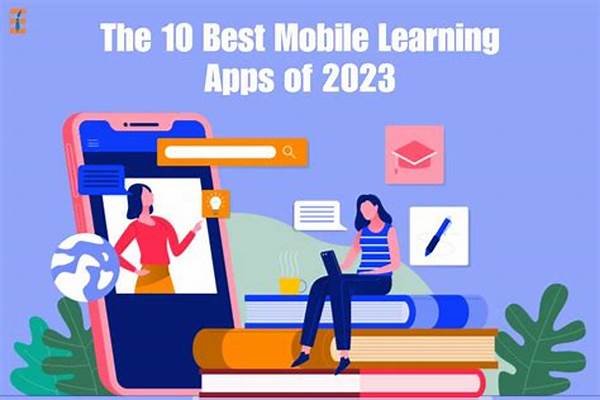The Rise of Mobile Learning Apps for Students
Read More : Tambakbet Compares Cheapest Vs Premium Courses: Value Analysis
Once upon a time, the idea of learning outside of a classroom seemed like something from a sci-fi movie. Yet here we are, living in a world where education fits snugly into our pockets thanks to the rise of mobile learning apps for students. It’s not just a convenience; it’s a revolution. Imagine a student named Jake, juggling homework between soccer practice and piano lessons. Now, instead of carrying heavy textbooks or waiting to ask his teacher questions, Jake can just whip out his smartphone and tap into a universe of knowledge. It’s like having a personal tutor available 24/7.
This rapid evolution in education technology is more than just a passing trend. According to recent statistics, the market for mobile learning applications is expected to reach over $9 billion by 2025. That’s a lot of zeros and proves that mobile learning is here to stay. But why the sudden surge? For one, these apps cater to a generation raised on technology. They are inherently interactive and often incorporate gaming elements, making learning engaging and, dare I say, fun? For students like Jake, learning no longer feels like a task but a journey filled with exciting milestones.
One of the significant benefits of mobile learning apps is their inclusivity. Students from various backgrounds now have access to resources that once seemed out of reach. Whether a student is in a bustling city or a remote village, as long as they have a mobile device and internet connectivity, the world is their oyster. These apps are breaking down geographical and economic barriers, leveling the educational playing field. And it’s not just students who benefit; teachers and parents can monitor progress, customize learning paths, and be more involved in the educational journey.
Tapping into the Education Revolution
For those with memories of chalkboards and overhead projectors, the rise of mobile learning apps for students might feel like science fiction. But trust us, it’s more of a blockbuster hit in the making than you might think.
—Description of the Rise of Mobile Learning Apps for Students
Have you noticed how our smartphones are seemingly glued to our hands? It’s no secret that mobile devices have drastically changed how we communicate and consume information. The education sector is no exception. With the rise of mobile learning apps for students, education is eventually catching up with technology’s fast pace. Students like our friend Jake no longer have to leaf through dusty textbooks. Instead, a simple tap or swipe reveals a world of bite-sized lessons, interactive quizzes, and even AI-powered study suggestions tailored just for them.
One of the charms of these apps is their ability to fit into every lifestyle. Are you a morning person who craves the dawn for reading? Or perhaps an evening owl who finds peace under the stars? Mobile learning apps don’t judge; they’re available anytime, anywhere. This flexibility has contributed significantly to their popularity. More than just a passing fad, these apps address the core needs of modern-day students who lead busy, multifaceted lives. In 2020 alone, app downloads for educational purposes saw a surge of over 90% compared to the previous year.
Honing the Power of Learning Anytime, Anywhere
The allure of mobile learning apps doesn’t end with availability. The personalization factor is a big hook. These apps intelligently analyze a student’s performance and learning habits, adapting to fit their unique strengths and weaknesses. It’s like switching from a one-size-fits-all sweater to a custom-tailored fit—no more itchy seams or saggy sleeves!
Why Mobile Learning Apps Are Here to Stay
Interactive and engaging, mobile learning apps speak the language of today’s digital-native students. With elements of gamification, they turn the learning process into an adventure or a challenging game. Who wouldn’t want to gain knowledge by earning points or unlocking new levels? Encouragement breeds motivation, and before you know it, learning becomes second nature.
It’s not just the students who are raving about the rise of mobile learning apps for students. Parents and educators are on board too, and educational institutions are incorporating them into their curriculums. As Anthony, a high school teacher, shared in a recent interview, “These apps have transformed how I teach. I can provide supplementary materials that cater to each student, making sure no one is left behind.”
Incorporating mobile learning apps into the digital fabric of education also offers a notable eco-friendly benefit. With digital resources, the need for excessive paper use diminishes, making a tiny yet crucial contribution to environmental conservation. The trees might not be able to say thank you directly, but rest assured, they appreciate it.
—Objectives of the Rise of Mobile Learning Apps for Students
—Structuring the Future of Educational Technology
The landscape of education is a vivid mosaic of styles, strategies, and technologies. The rise of mobile learning apps for students is not an isolated wave but rather a crucial piece of this educational puzzle. It’s interlinked with the goal of crafting a versatile and adaptable learning environment that can nimbly respond to each student’s unique requirements. This adaptability is the first step towards forging an educational framework robust enough to withstand the modern world’s demands.
Mobile learning apps are more than mere supplemental tools; they’re reshaping our understanding of what holistic education looks like. As they continuously evolve, they include diversified content ranging from video lectures led by subject matter experts to discussion forums simulating classroom debates. The amalgamation of such varied forms of information enriches the learning experience, making it more comprehensive and, ironically, less overwhelming than yesteryears’ textbook-laden homework assignments.
The benefits extend further into fostering an independent learning culture among students. Encouraging exploration beyond the standard syllabus, it instills a sense of confidence and curiosity. When students are driven not by rigid structures but by genuine interest and individualized goals, it transforms the narrative from “I have to learn this” to “I want to learn this.” This pivotal change is what fortifies students to approach challenges head-on, inspired by their personalized educational journeys.
As we delve deeper into this technology-driven era, what remains crucial is the collaborative synergy between app developers, educators, policy-makers, and students themselves. Ensuring that the rise of mobile learning apps for students continues to serve its purpose, this coalition thrives on responsive updates, innovative designs, and a commitment to making education universally accessible. With every click, swipe, and tap, the education sector marches towards a future brimming with promise and potential.
The Road Ahead in Mobile Learning
Looking to the horizon, it’s not just about adapting to changes as they come but anticipating and embracing perhaps even more novel ways to integrate technology with learning. The march continues, one app at a time.
—Illustrations of the Rise of Mobile Learning Apps for Students
—
Article creation on “the rise of mobile learning apps for students” is multifaceted and positions itself strategically for the modern education paradigm. By understanding the roles these apps play, educators and students can maximize their potential in creating an enriched educational experience.


